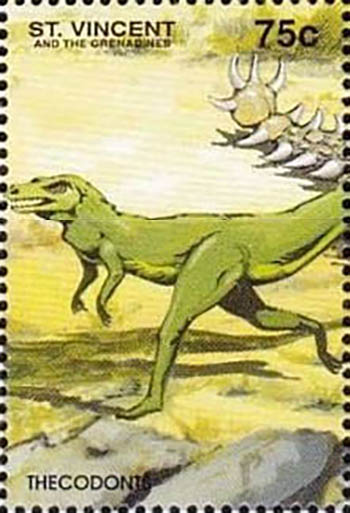Thecodontosaurus antiquus Morris, 1843

(Da: it.wikipedia.org)
Phylum: Chordata Haeckel, 1874
Subphylum: Vertebrata Cuvier, 1812
Classe: Dinosauria Owen, 1841
Ordine: Saurischia Seeley, 1887
Famiglia: Thecodontosauridae Lydekker, 1890
Genere: Thecodontosaurus Riley & Stutchbury, 1836
Descrizione
Questo dinosauro, lungo circa due metri, è uno dei sauropodomorfi più primitivi. Le lunghe zampe dotate di artigli e il cranio lo fanno assomigliare a un teropode, e probabilmente il tecodontosauro era una forma onnivora. Il cranio e i denti sono di foggia particolarmente antiquata, ed è possibile che da questo animale derivino tutti i successivi sauropodomorfi, compresi i giganti del Giurassico come il Diplodocus, l’Apatosaurus (= Brontosaurus) e Brachiosaurus. Il collo era lungo e serpentino mentre le zampe sembrerebbero essere state già predisposte per uno stile di vita semibipede. Il Thecodontosaurus antiquus è stato uno dei primi dinosauri ad essere descritti scientificamente: i suoi resti furono rinvenuti in depositi di fessura e vennero descritti nel 1836 da Riley e Stutchbury (il nome della specie fu però apposto da Morris nel 1843). Questi depositi permettono un'ottima conservazione degli esemplari e così il tecodontosauro è un animale piuttosto ben conosciuto, grazie anche ai molteplici ritrovamenti (almeno tredici individui). Si pensava che la maggior parte dei resti fosse andata distrutta con i bombardamenti della Seconda guerra mondiale, ma in realtà molti esemplari erano stati conservati presso altre istituzioni, e ora è in corso un'operazione di ristudio di tutto il materiale. Il T. antiquus potrebbe essere dimorfico. Una curiosità: il cosiddetto "Agrosaurus" descritto da Harry Seeley nel 1891 e ritenuto essere il più antico esemplare di dinosauro australiano, è in realtà basato su resti frammentari mal catalogati, che in realtà provenivano dall'Inghilterra e appartenevano con ogni probabilità al Thecodontosaurus antiquus. Un'altra specie il T. caducus, è stata descritta nel 2003 da Adam Yates, anche se i resti sulla quale è basata erano stati rinvenuti nel Galles nel 1952. Questo esemplare è basato su uno scheletro incompleto del quale si è conservata solo la metà anteriore. Il cranio sembra avere reminiscenze di quello dell’Eoraptor, e potrebbe essere una specie più primitiva della specie tipo. Per questo, nel 2007 la specie è stata ascritta a un nuovo genere, il Pantydraco.
Diffusione
Dinosauro molto primitivo vissuto nel Triassico superiore (Norico - Retico, circa 220 milioni di anni fa) nel territorio che è ora la Gran Bretagna.
Sinonimi
= Agrosaurus Seeley, 1891.
Bibliografia
–M.J. Benton, L. Juul, G.W. Storrs and P.M. Galton, 2000, "Anatomy and systematics of the prosauropod dinosaur Thecodontosaurus antiquus from the upper Triassic of southwest England", Journal of Vertebrate Paleontology 20(1): 77-108.
–Simms, Michael J.; Drost, Kerstin (2024). "Caves, dinosaurs and the Carnian Pluvial Episode: Recalibrating Britain's Triassic karst 'fissures'". Palaeogeography, Palaeoclimatology, Palaeoecology. 638: 112041.
–Adrian Desmond (15 April 1992). The Politics of Evolution: Morphology, Medicine, and Reform in Radical London. Chicago: University of Chicago Press. p. 427.
–Williams, (1835), "Discovery of Saurian Bones in the Magnesian Conglomerate near Bristol", American Journal of Science and Arts 28: 389.
–Riley, H., and Stutchbury, S., (1836), "A description of various fossil remains of three distinct saurian animals discovered in the autumn of 1834, in the Magnesian Conglomerate on Durdham Down, near Bristol", Proceedings of the Geological Society of London 2: 397-399.
–Morris, J., 1843, A Catalogue of British Fossils. British Museum, London, 222 pp.
–A.S. Woodward and C.D. Sherborn, 1890, A Catalogue of British Fossil Vertebrat Dulao & Company, London pp. 396.
–F. v. Huene, 1908, "On phytosaurian remains from the Magnesian Conglomerate of Bristol (Rileya platyodon)", Annals and Magazine of Natural History, series 8 1: 228-230.
–Seeley, H.G., 1891, "On Agrosaurus macgillivrayi, a saurischian reptile from the northeast coast of Australia", Quarterly Journal of the Geological Society of London 47: 164-165.
–Vickers-Rich, P., Rich, T.H., McNamara, G.C. & Milner, A. (1999). "Agrosaurus: Australia's oldest dinosaur?". Records of the Western Australian Museum Supplement 57: 191-200.
–Skawinski, T.; Ziegler, M.; Czepinski, L.; Szermanski, M.; Talanda, M.; Surmik, D.; Niedzwiedzki, G. (2017). "A re-evaluation of the historical 'dinosaur' remains from the Middle-Upper Triassic of Poland". Historical Biology. 27 (4): 442-472.
–Haughton, S.H., 1924, "The fauna and stratigraphy of the Stormberg Series", Annals of the South African Museum 12: 323-497.
–S.H. Haughton, 1932, "On a collection of Karroo vertebrates from Tanganyika Territory", Quarterly Journal of the Geological Society of London 88(4): 634-671.
–Nesbitt, S. J.; Barrett, P. M.; Werning, S.; Sidor, C. A.; Charig, A. J. (2013). "The oldest dinosaur? A Middle Triassic dinosauriform from Tanzania". Biol. Lett.
–Yates, A. M. (2003). "A new species of the primitive dinosaur Thecodontosaurus (Saurischia: Sauropodomorpha) and its implications for the systematics of early dinosaurs". Journal of Systematic Palaeontology 1 (1): 1-42.
–Galton, P.M., Yates, A.M., & Kermack, D. (2007). "Pantydraco n. gen. for Thecodontosaurus caducus Yates, 2003, a basal sauropodomorph dinosaur from the Upper Triassic or Lower Jurassic of South Wales, UK". Neues Jahrbuch für Geologie und Paläontologie, Abh., 243: 119-125.
–Antonio Ballell; Emily J. Rayfield; Michael J. Benton (2020). "Osteological redescription of the Late Triassic sauropodomorph dinosaur Thecodontosaurus antiquus based on new material from Tytherington, southwestern England". Journal of Vertebrate Paleontology. 4 (2): e1770774.
– Whiteside, D.I. and Marshall, J.E.A. (2008) "The age, fauna and palaeoenvironment of the Late Triassic fissure deposits of Tytherington, South Gloucestershire, UK". Geological Magazine, 14(1): 105-147.
–Wikisource reference Huxley, Thomas H. (1870). "On the Classification of the Dinosauria, with observations on the Dinosauria of the Trias". Quarterly Journal of the Geological Society of London. Vol. 26. pp. 32-51.
–Upchurch, P. (1998). "The phylogenetic relationships of sauropod dinosaurs". Zool. J. Linnean Soc. 124: 43-103.
–Yates, A.M. & Kitching, J. W. (2003). "The earliest known sauropod dinosaur and the first steps towards sauropod locomotion". Proc. R. Soc. Lond.: B Biol Sci. 2003 Aug 22; 270(1525): 1753-8.
–Ballell, A.; Rayfield, E.J.; Benton, M.J. (2022). "Walking with early dinosaurs: appendicular myology of the Late Triassic sauropodomorph Thecodontosaurus antiquus". Royal Society Open Science. 9 (1): 211356.

|
Data: 20/04/1994
Emissione: Animali preistorici Stato: St. Vincent and the Grenadines Nota: Emesso in un foglietto di 12 v. diversi |
|---|